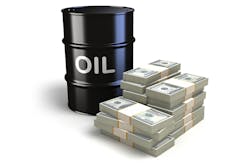Despite predictions from several analysts that oil prices would rise in the second half of 2016, they in fact dropped once again this week below $40 a barrel. That might seem like bad news for oil exploration companies and the automation suppliers trying to sell their wares to them, but maybe it’s for the best in the long run.
At the Offshore Technology Conference (OTC) in Houston earlier this year, automation suppliers were eager to talk about how their products can help oil and gas producers survive in a climate of low oil prices. Automation and standardization are key, of course, to optimize processes and improve efficiencies—not just lay off workers when prices are down and try to lure them back when business turns around again.
This idea has been catching on with the oil exploration companies. They’ve come to realize that they need to think differently about their wildcatting tendencies, and focus on optimizing their operations. “The downstream industry has been very focused on incremental improvements, but upstream has been allowed to be inefficient, and just drill more oil wells,” commented Larry Irving, vice president of global oil and gas for Emerson Process Management. “It’s worked quite well in the past, so why change?”
With oil prices reaching historic lows, however, it’s not working so well anymore, and things have had to change. The operating efficiency mindset of the refineries has made its way upstream, and that is where the future lies, Irving said.
But the flip side of all of this is: What if oil prices come back too quickly? Will those lessons learned be undone as they race to once again just get as much oil out of the ground as quickly as they can?
There does seem to be some concern about that.
“The upstream guys are cowboys,” Irving said. “They do what they want, and they don’t want to change.”
Customers are inviting ideas from Emerson and other automation suppliers, though, about how to make innovative changes, and they’re listening, Irving said. “But you can’t underestimate the need for change management.”
“The best thing that can happen to this industry is for the oil price to not come back quickly. If it hits $100 again within the next year, they’ll forget about all these efficiencies,” said Luis Gamboa, oil and gas market development manager for Rockwell Automation. “But if it comes back slowly, it’s going to change this industry.”
But at their latest Connect conference in New Orleans in May, Schneider Electric experts argued against the notion that increased automation levels in the oil and gas industry have been driven by low oil prices.
“This is something that’s been brewing for years,” said Gary Freburger, president of Schneider Electric’s Process Automation Industry Business. “The industry recognized that the position they’ve gotten themselves in with how projects are executed—the risk, how much more complex they are—with all that comes cost. They’ve all been thinking and heading down the path of doing something about that. I don’t think it’s anything that the oil prices themselves forced them to do.”
Chris Lyden, senior vice president of strategy, process automation, for Schneider Electric referenced the project work of a “very, very large multinational oil company,” noting that all the processes and standards put in place for good reasons years ago have now become an “overwhelming set of baggage to carry.”
“They knew they were carrying too much overhead,” Lyden said. “The low oil price pushes them more, but they already needed to do it differently.”
ExxonMobil’s Sandy Vasser has made a well publicized push to change the technology behind oilfield automation supply—using universal I/O, fewer and standardized cabinets, and less wiring, and eliminating the need for factory acceptance testing (FAT), to name a few. And all of this came about well before oil prices dropped. “There’s a tremendous amount of work being done already to get cost out,” Lyden said.
Shell Oil has been “embracing new technologies that could potentially revolutionize the way deepwater competes,” said Wael Sawan, executive vice president deepwater for Shell, during a panel discussion at OTC. “That entire marginal cost structure will keep coming down.”
But Shell and other oil drilling companies must take care to maintain that legacy when prices come back, Sawan added, “making sure that we don’t allow that waste to creep back in.”
Leaders relevant to this article:

